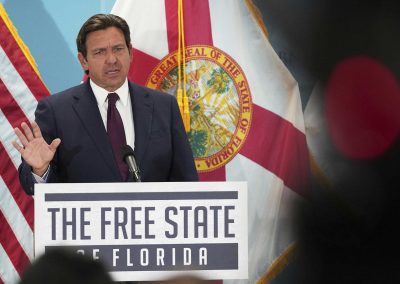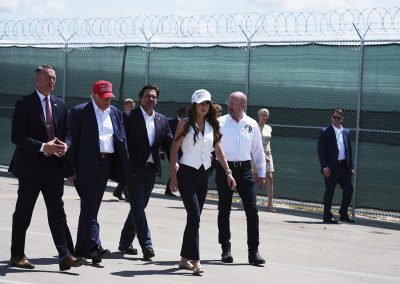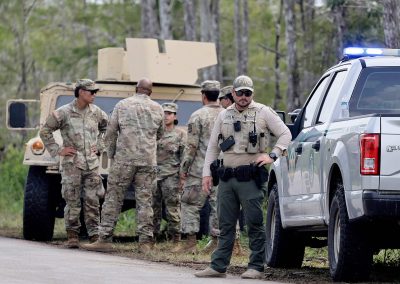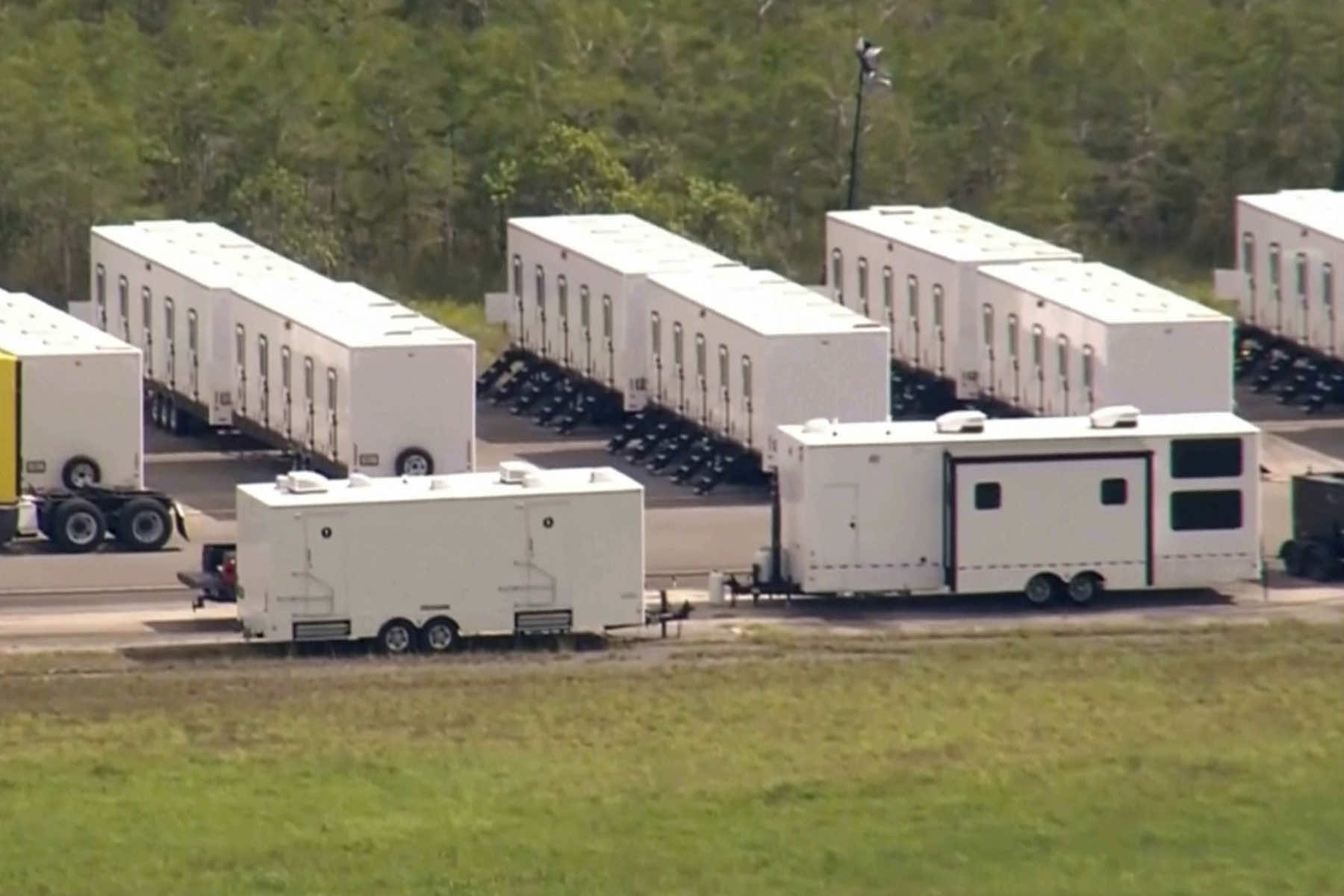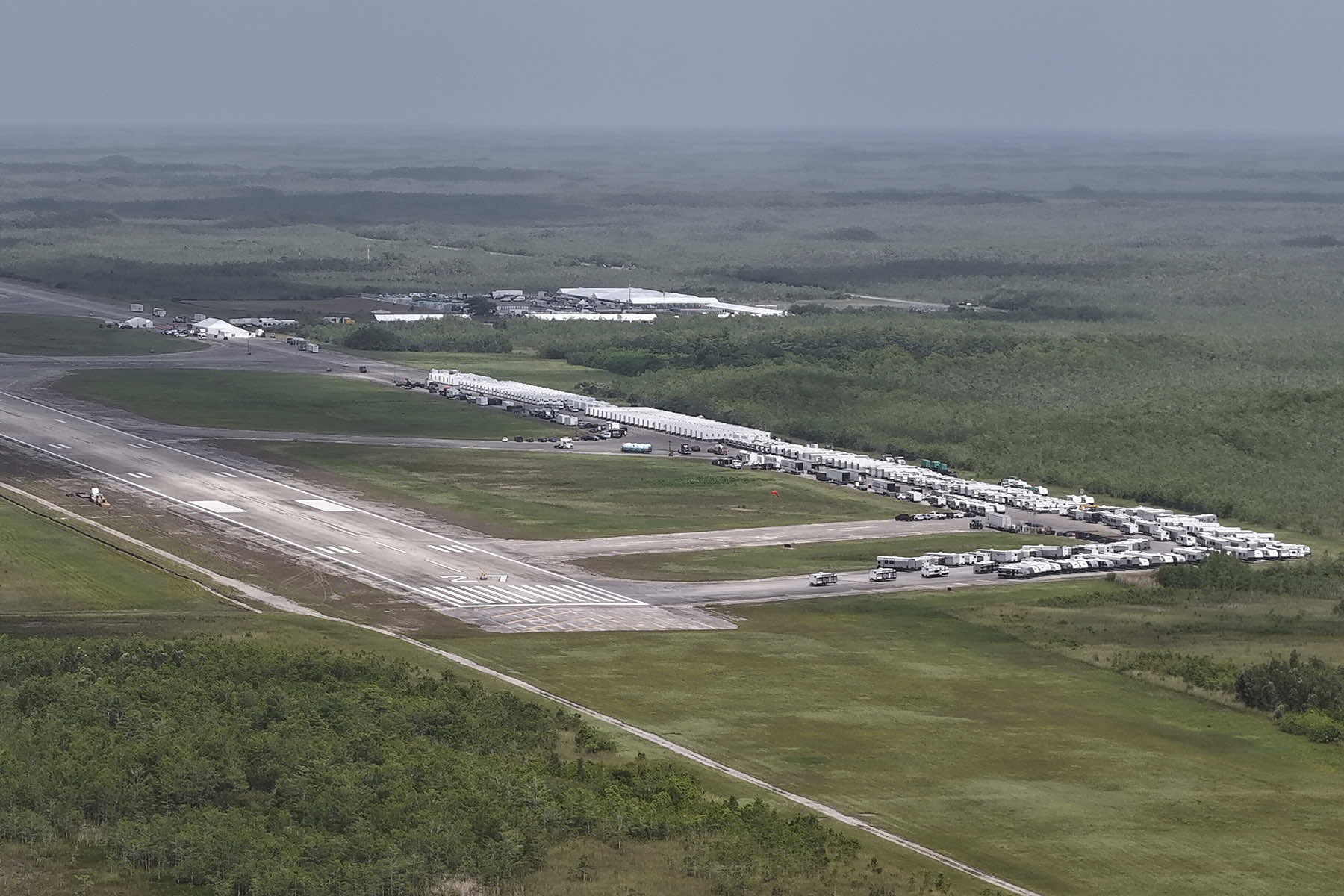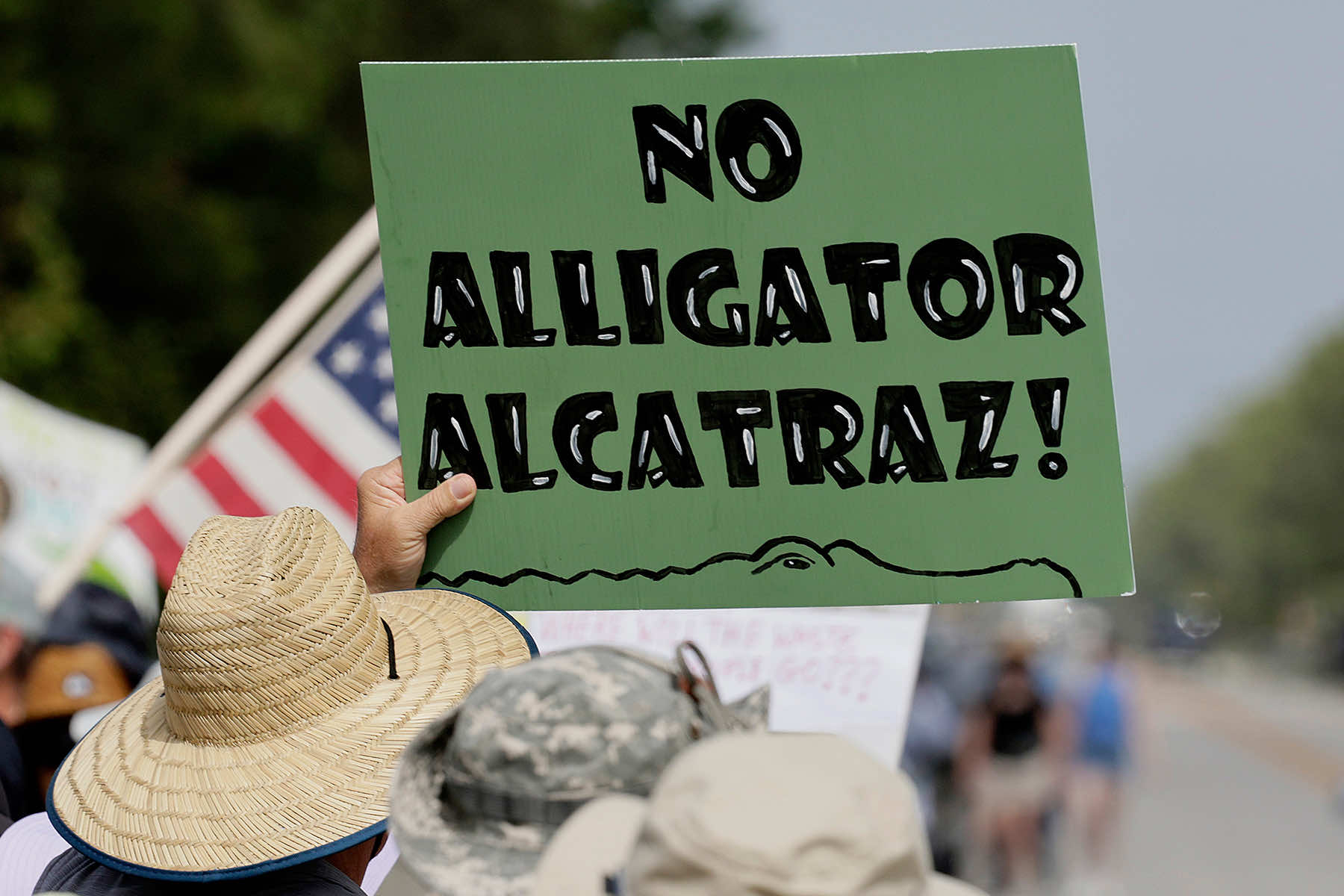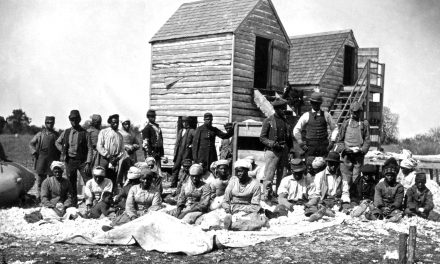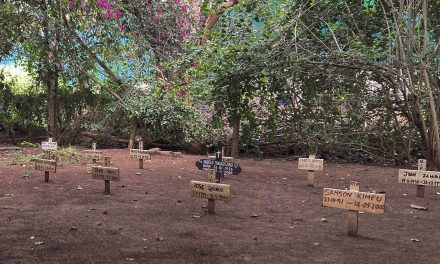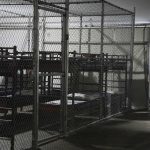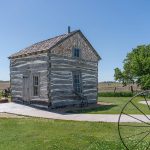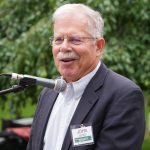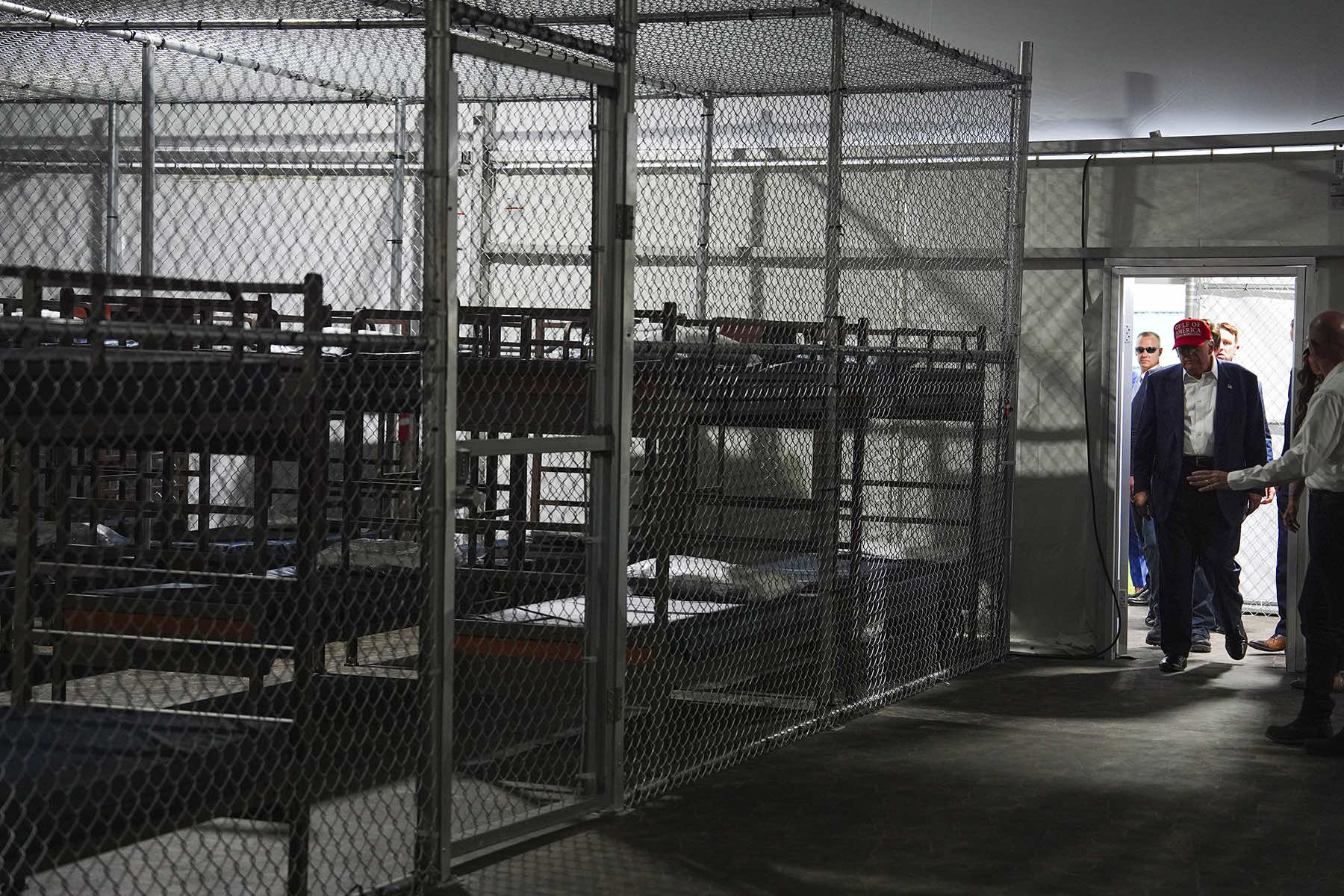
The new immigration detention center at an isolated airstrip in the Florida Everglades that Donald Trump visited on July 1 was heralded by Republicans as a potential model for other states to aggressively ramp up detention and deportation efforts.
Trump, Department of Homeland Security Secretary Kristi Noem, and other state and federal officials toured the facility, which was built by Florida Governor Ron DeSantis’ administration in a matter of days and is expected to receive its first detainees on July 2.
The site can currently house 3,000 people in dormitories corralled by chain-link fences and topped with barbed wire, and state officials say it can be expanded to ultimately house 5,000.
“We’re surrounded by miles of treacherous swampland and the only way out is, really, deportation,” Trump said, adding, “This is an amazing thing that they’ve done here.”
“This is not a nice business,” Trump said. Then he joked that “we’re going to teach them how to run away from an alligator if they escape prison.”
“Don’t run in a straight line. Run like this,” he said, as he moved his hand in a zigzag motion. “And you know what? Your chances go up about 1%.”
That does not seem to be sound advice, though. It is best to dash in one direction in the rare situation when an alligator gives chase, according to a website run by the University of Florida.
Assembled on a remote airstrip with tents and trailers that are normally used after a natural disaster, the detention center has been nicknamed “Alligator Alcatraz,” a moniker that has alarmed immigrant activists but appeals to the aggressive approach of Republicans and their MAGA supporters for deportations.
The facility is located at an isolated airfield about 45 miles west of downtown Miami and is surrounded by swamps filled with mosquitoes, pythons, and alligators.
IT TOOK JUST DAYS TO BUILD
Florida officials raced to erect the compound of heavy-duty tents, trailers and temporary buildings in eight days, as part of the state’s muscular efforts to help carry out Trump’s immigration crackdown. The center is estimated to cost $450 million a year, with the expenses incurred by Florida and reimbursed by the Federal Emergency Management Agency, a U.S. official said.
Inside, rows of bunk beds are cordoned off by lines of chain-link fencing, where migrants could be housed for days, weeks, or months. Officials say detainees will have access to medical care, 24/7 air conditioning, and a rec yard, as well as support from attorneys and members of the clergy.
The facility is meant to help the Trump administration reach its goal of more than doubling its existing 41,000 beds for detaining migrants to at least 100,000 beds.
DHS Secretary Kristi Noem said the new facility will be funded in large part by the Shelter and Services Program within the Federal Emergency Management Agency, or FEMA, which is best known for responding to hurricanes and other natural disasters.
“We are working at turbo speed on cost-effective and innovative ways to deliver on the American people’s mandate for mass deportations of criminal aliens,” said Noem in a written statement. “We will expand facilities and bed space in just days.”
Managing the facility “via a team of vendors” will cost $245 a bed per day or approximately $450 million a year, a U.S. official said. The expenses will be incurred by Florida and reimbursed by FEMA, which has a $625 million shelter and service program fund.
Immigrants arrested by Florida law enforcement officers under the federal 287 (g) program will be held at the facility, as well as immigrants in the custody of U.S. Immigration and Customs Enforcement, or ICE.
Under the revived 287 (g) program, local and state law enforcement officers can interrogate immigrants in their custody and detain them for potential deportation.
Agencies across all 67 Florida counties have signed more than 280 such agreements, more than a third of the 720 agreements ICE has reached nationwide.
The site’s remote location, entirely surrounded by rough and rugged wetlands, is meant to be a deterrent against illegal immigration and a motivator for detainees to self-deport.
“You don’t always have land so beautiful and so secure. You have a lot of bodyguards and a lot of cops that are in the form of alligators. You don’t have pay them so much,” Trump said.
Florida Attorney General James Uthmeier, whom Noem has credited as the architect of the Everglades plan, first debuted the proposal with a slickly produced video, complete with custom graphics featuring red-eyed alligators and a hard rock soundtrack.
The Department of Homeland Security posted an image of alligators wearing ICE hats and sitting in front of a fenced-in compound ringed with barbed wire.
The Florida Republican Party has fundraised off the facility, selling branded T-shirts and beverage container sleeves. DeSantis suggested on June 30 that the facility would be open and “ready for business” by the time Trump arrives.
The governor, who challenged Trump for the 2024 Republican presidential nomination, has also played up the fact that the site will be hard to escape from.
“They ain’t going anywhere once they’re there, unless you want them to go somewhere, because good luck getting to civilization,” DeSantis said. “So the security is amazing.”
BACKERS CALL IT A “ONE-STOP SHOP”
State officials are showcasing what critics are condemning as an inhumane makeshift prison camp, but what supporters say is an “innovative” and “cost-effective” approach to the federal government’s pressing problem: how to operationalize enough detention space to carry out Trump’s mass deportation agenda.
To help speed up the process, DeSantis is offering up members of the state’s National Guard to be “deputized” as immigration judges to hear detainees’ cases, as a way to loosen another chokepoint in the country’s long-overburdened immigration court system.
“I would ask every other governor to do the exact same thing,” Noem said. “This is unique because we can hold individuals here. They can have their hearings, to get due process, and then immediately be flown back home to their home countries.”
“I hope my phone rings off the hook from governors calling and saying, ‘How can we do what Florida just did?'” she added.
IT WILL NOT BE THE ONLY ONE
DeSantis said on July 1 that the state is moving forward with building another makeshift detention center for migrants at a National Guard training facility called Camp Blanding, about 30 miles southwest of Jacksonville in northeast Florida.
State officials have opened a bid for contractors on that site, which is expected to hold another 2,000 beds, with plans to start construction there after the July 4 holiday.
The state is pouring significant resources into the makeshift facilities and hiring private contractors to help build and supply the sites, even as a recent report suggested that Florida has thousands of vacant beds in county jails and detention centers that already exist.
According to a state report, as of March 28, 2025, there were more than 7,500 vacant beds available to sublet to ICE for use as immigration detention beds.
FLORIDA USES EMERGENCY POWERS TO BUILD THE SITE
State officials have commandeered the land using emergency powers, under a years-old executive order issued by DeSantis during the administration of then-President Joe Biden to respond to what the governor deemed a crisis caused by illegal immigration.
Relying on the emergency order, the state has fast-tracked the project, sidestepping laws and regulations in what critics have called an abuse of power.
State officials say the installation is critical to support Trump’s mass deportation agenda, which has pushed detentions to a record high, totaling more than 56,000 immigrants in June, the most since 2019.
“Governor DeSantis has insisted that the state of Florida, under his leadership, will facilitate the federal government in enforcing immigration law,” a DeSantis spokesperson said in a statement.
“Florida will continue to lead on immigration enforcement.”
IT HAS DRAWN HUNDREDS OF PROTESTERS
Hundreds of immigrant advocates, environmental activists, and Native Americans defending their ancestral homelands have thronged to the airstrip to protest. Now, they are rallying to halt what some critics have described as a state-backed “heist.”
“Surrounded by Everglades National Park and Big Cypress National Preserve, this land is part of one of the most fragile ecosystems in the country,” reads a statement from the advocacy group Friends of the Everglades. “Let’s not repeat the mistakes of the past. This land deserves lasting protection.”
Florida Democratic U.S. Representative Maxwell Frost condemned the detention center, calling its apparent use of alligators as a security measure a “cruel spectacle.”
“Donald Trump, his Administration, and his enablers have made one thing brutally clear: they intend to use the power of government to kidnap, brutalize, starve, and harm every single immigrant they can — because they have a deep disdain for immigrants and are using them to scapegoat the serious issues facing working people,” Frost said in a statement.
Maria Asuncion Bilbao, Florida campaign coordinator at American Friends Service Committee, an immigration advocacy group, warned that the health and safety of detainees are being put at risk.
“What’s happening is very concerning, the level of dehumanization,” Bilbao said. “It’s like a theatricalization of cruelty.”
Bilbao, who leads a group of immigration advocates who help immigrants at one of the ICE offices in South Florida, said she’s concerned about the health risks of the heat and mosquitoes, and the challenges the remoteness of the site presents to community members hoping to protest or monitor activities there.
On June 28, as dump trucks hauling construction materials lumbered into the airfield, demonstrators waved signs calling for the protection of the expansive preserve as passing cars honked in support.
In Big Cypress National Preserve, where the airstrip is located, 15 traditional Miccosukee and Seminole villages, as well as burial grounds and ceremonial sites, remain.
More than 50 years ago, environmental advocates, including the famed Marjory Stoneman Douglas, rallied to stop the same stretch of land from being turned into what was to be the largest airport in the world.
Worries about environmental impacts have also been at the forefront, prompting the Center for Biological Diversity and the Friends of the Everglades to file a lawsuit on June 27 to halt the detention center plans.

